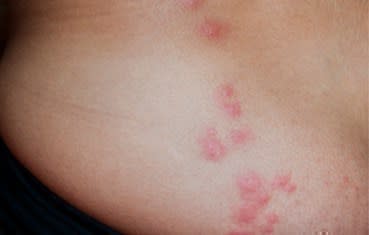Bedbugs: Overview
What are bedbugs?
Bedbugs are tiny insects that feed on human blood. They hide in dark places close to where humans sleep and usually crawl out to feed while people are fast asleep.
If you have bedbugs in your home, it's unlikely that you'll see one unless you look for them. Bedbugs hide in the crevices of mattresses, box springs, headboards, couches, and other places. They only come out to feed.
While a bedbug is feeding on you, you're unlikely to notice. Most people are asleep when they get bit. Also, before a bedbug draws your blood, it injects you with a substance that prevents you from feeling the bite. When you wake up, you may notice itchy welts.
Bedbug bites
Most people who are bitten by bedbugs have welts that look like this.

To find bedbugs, you usually have to look carefully. An adult that is full of blood can be the size of an apple seed. Hungry bedbugs and younger ones are about the size of a poppy seed.
If you unsure of what’s biting you, a board-certified dermatologist can often look at the bites and tell you whether bedbugs are the cause.
Bedbugs can be hard to find
They are often about size of a poppy seed.

As for getting rid of bedbugs, it often requires professional help. Pesticides are usually necessary to kill bedbugs and their eggs, but using these on or near your bed can be hazardous to your health. This is why the Centers for Disease Control (CDC) recommends using a professional pest control company that has experience treating bedbugs.
To complicate matters, many pesticides and foggers cannot kill bedbugs because bedbugs have developed a resistance to the active ingredients in these products. It takes a bit of knowledge to know what will work.
If this news makes you want to leave your home for a few weeks, well, that won’t get rid of bedbugs either. Bedbugs can survive one year or longer without eating.
Another good reason to get professional help is to make sure you actually have bedbugs. Many insect bites cause itchy welts.
Images
Getty Images
References
Centers for Disease Control and Prevention and U.S. Environmental Protection Agency. “Joint statement on bed bug control in the United States from the U.S. Centers for Disease Control and Prevention (CDC) and the U.S. Environmental Protection Agency (EPA).” Atlanta: U.S. Department of Health and Human Services; 2010.
Steen CJ, Carbonaro PA, Schwartz RA. “Arthropods in dermatology.” J Am Acad Dermatol 2004; 50:819-42.
 Atopic dermatitis: More FDA-approved treatments
Atopic dermatitis: More FDA-approved treatments
 Biosimilars: 14 FAQs
Biosimilars: 14 FAQs
 How to trim your nails
How to trim your nails
 Relieve uncontrollably itchy skin
Relieve uncontrollably itchy skin
 Fade dark spots
Fade dark spots
 Untreatable razor bumps or acne?
Untreatable razor bumps or acne?
 Tattoo removal
Tattoo removal
 Scar treatment
Scar treatment
 Free materials to help raise skin cancer awareness
Free materials to help raise skin cancer awareness
 Dermatologist-approved lesson plans, activities you can use
Dermatologist-approved lesson plans, activities you can use
 Find a Dermatologist
Find a Dermatologist
 What is a dermatologist?
What is a dermatologist?